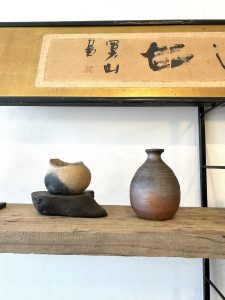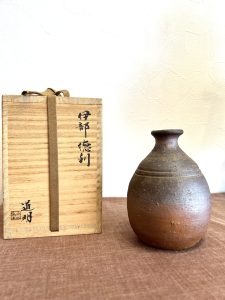触れてみないと分からない温もり(愛知県名古屋市千種区姫池通 骨董買取 古美術風光舎)
2023.11.01
皆さまこんにちは。スタッフHでございます。
ひんやりとした風とともに「秋あがり」や「ひやおろし」などの日本酒が美味しい季節となりました。蔵の中でひと夏ゆっくりと熟成され、涼しくなった秋に出荷される日本酒です。
ここ風光舎にもぽってりと美しい備前焼の徳利がございます。持ってみると手のひらの丸みにすっぽりと収まり、ずっと撫でていたいと思わせる肌触りです。金重道明氏の作品です。

備前焼は表面に微細な凹凸があり、ビールの泡をきめ細かく発砲させ、泡を長く維持できることで知られていますが、日本酒にも最適な器のようです。内部に微細な気孔があり若干の通気性があるため日本酒、ウィスキー、ワインなどを備前焼に入れておくと、香り高くまろやかでコクのある味へと変化するとか。コーヒーもこの気孔のおかげで美味しくいただけるそうです。
備前焼は、瀬戸や常滑などとともに六古窯の一つに数えられ、岡山県備前市の伊部(いんべ)地区が代表的な産地です。古墳時代中頃に朝鮮半島から伝わった須恵器(すえき)をルーツとし、次第に変化しながら平安時代に生活用の碗、皿、盤や瓦などが生産されたのが始まりといわれています。室町時代末期頃には茶人たちに使われるようになり、豊臣秀吉など戦国武将にも愛されました。

土は干寄(ヒヨセ)と呼ばれる田畑から採掘される粘土を使用し、釉薬を使わず、絵付けもせず、1200度程度の高温で焼き締めます。
焼成時の窯の中の状態や、窯のどの位置に置くかによって焼き物の色や表情が変化するため、二つと同じものがない「土と炎の芸術」とも呼ばれています。
現在は焼成期間が2週間から1カ月程だそうですが、江戸時代頃は数カ月焼き続けることもあったそうです。長期間焼くことで土が焼締まり、表面がしっとりと滑らかにな上質の手触りになるのだとか。
焼くという作業や窯の形にかなりの重点を置いている備前焼の陶工は、火を操る職人とも言えます。
焼き上がりについては、その特徴ごとにいくつかの分類がされます。
還元焼成により代表的な焼き色の金、黒、白、灰、茶などの様々な色が出る「棧切り(さんぎり)」。藁を巻いて焼き、緋色のたすきをかけた模様が出る「緋襷(ひだすき)」。松の木の灰が胡麻のような模様となる「胡麻」。器を横にして灰に埋もれた状態で焼き、表面が黒、青、グレーなどのガラス状に焼け上がる「ころがし」。絵柄とは趣の違う様々な土の表情が楽しめます。
自然の成り行きに任せる焼き方ともいわれますが、無作為のように見える中にも、長年の経験からくる勘という作為が確実に存在しています。それを感じ取ることのできる感性を磨きたいのですが、一朝一夕に得られるものではないですね。
実用的な話になりますが、備前焼は洗剤では洗わず、水につけておくだけにして、あとは風通しのいいところで乾かすようにします。徳利の口が細いので、どうやって洗うのだろうという私のような素人の悩みは不要なのです。
そして毎回使う前に水にくぐらせる。お猪口などは毎回使いはじめに5分間水につけると口当たりがよくなるそうです。
使うほどに味が出て、呼吸をしているような備前焼。是非手元において育ててみたい焼き物です。
それでは、またお会いしましょう。

Hello everyone. This is Staff H.
With the cool breeze, it is now the season for sake, such as “autumn-aged” and “hiyaoroshi” sake, to be enjoyed. Sake is matured slowly in the brewery over the summer and shipped in the fall when the weather turns cooler.
Here at Fumikosha, we have a beautiful Bizen ware sake bottle. When you hold it, it fits perfectly in the roundness of your palm, and its texture makes you want to stroke it all the time. It is the work of Michiaki Kanashige.
Bizen ware is known for its fine irregularities on the surface, which make the foam of beer finer and keep it for a longer time, but it also seems to be the best vessel for sake. The fine pores inside allow some ventilation, so when sake, whiskey, wine, and other beverages are placed in Bizen ware, they become more aromatic, mellow, and full-flavored. Coffee is also said to taste better thanks to these pores.
Bizen ware is one of the six oldest kilns, along with Seto and Tokoname, and the Ibe district of Bizen City, Okayama Prefecture, is a representative production area. It is said that the origin of Bizen ware dates back to the Sue ware introduced from the Korean Peninsula in the middle of the Kofun period, and that the production of bowls, plates, boards, and roof tiles for daily use gradually changed during the Heian period (794-1185). By the end of the Muromachi period (1333-1573), it was used by tea masters and was loved by warlords such as Toyotomi Hideyoshi.
The clay is hiyose, which is mined from the fields, and fired at a high temperature of about 1,200 degrees Celsius without glaze or painting.
The color and appearance of the pottery changes depending on the condition of the kiln during firing and the position of the pieces in the kiln, and thus it is called “the art of clay and flame” in which no two pieces are alike.
The firing period is now said to be from two weeks to a month, but during the Edo period, firing was sometimes continued for several months. The long firing process tightens the clay and makes the surface moist and smooth to the touch.
Bizen potters, who place considerable emphasis on the firing process and the shape of the kiln, can be said to be craftsmen who manipulate fire.
Firing is classified into several categories according to its characteristics.
Sangiri,” or reduction firing, produces a variety of colors, including gold, black, white, ash, and brown, which are typical firing colors. Hidasuki,” in which straw is rolled and fired to produce a scarlet tasuki (sash) pattern. Goma,” in which the ashes of pine trees form a sesame-like pattern. Korogashi,” in which the vessel is fired on its side and covered in ash, resulting in a glassy black, blue, or gray surface. The various expressions of the clay, which are different from the patterns, can be enjoyed.
This is said to be a firing method that allows nature to take its course, but while it may seem random, there is definitely some artifice in the form of intuition based on years of experience. I would like to hone my sensibility to be able to sense this, but it is not something that can be acquired overnight.
To be realistic, I do not wash Bizen ware with detergent, but only soak it in water and then let it dry in a well-ventilated place. There is no need for amateurs like me to worry about how to wash it because the mouth of the Tokuguri is narrow.
Then, before each use, dip it in water. I hear that soaking a boar’s mouth in water for five minutes at the beginning of each use makes it more pleasant to the palate.
The more you use Bizen Pottery, the more it tastes and breathes. It is a pottery that I would like to keep on hand and nurture.
See you again soon.
*******************
ご実家の整理やお片付けなどをされている方のご相談などが多くございます。
お片付けなどくれぐれもご無理のないようになさってくださいませ。
風光舎では古美術品や骨董品の他にも絵画や宝石、趣味のお品など様々なジャンルのものを買受しております。
お片付けをされていて、こういうものでもいいのかしらと迷われているものでも、どうぞお気軽にご相談下さいませ。
また風光舎は、出張買取も強化しております。ご近所はもちろん、愛知県内、岐阜県、三重県その他の県へも出張いたします。
まずは、お電話お待ちしております。
愛知県名古屋市千種区姫池通
骨董 買取【古美術 風光舎 名古屋店】
TEL052(734)8444
10:00-17:00 OPEN
#出張買取#骨董#古美術#骨董品#絵画#版画#茶道具#刀剣#彫刻

